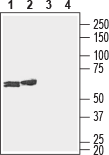Overview
- Peptide (C)GNDENEFI(S)HLGQPG, corresponding to amino acid residues 56-70 of mouse Connexin-29 (Accession Q921C1). 1st extracellular loop.
- Rat and mouse brain lysates (1:200–1:1000).
 Western blot analysis of rat (lanes 1 and 3) and mouse (lanes 2 and 4) brain lysates:1,2. Anti-Connexin-29 (extracellular) Antibody (#ACC-223), (1:200).
Western blot analysis of rat (lanes 1 and 3) and mouse (lanes 2 and 4) brain lysates:1,2. Anti-Connexin-29 (extracellular) Antibody (#ACC-223), (1:200).
3,4. Anti-Connexin-29 (extracellular) Antibody, preincubated with Connexin-29 (extracellular) Blocking Peptide (#BLP-CC223).
Gap junction channels play an important role in intercellular communication, important for maintaining cell homeostasis. The connexin (Cx) gene family encodes hexameric hemichannels called connexons. When those connexons are docked head to head they form channels. Their presence between adjacent cells form gap junctions. One gap junction is composed of two hexameric connexons and 12 connexins form a single channel1. Connexins have four transmembrane domains, two extracellular loops and one cytoplasmic loop and cytosolic amino and carboxyl termini2.
Connexins are responsible for transporting ions and small molecules between the cytoplasm of two attaching cells and between the cytoplasm and the extracellular space2.
21 connexins have been identified in humans and 20 in mice2. Connexin 29 was shown to be expressed in the cochlear tissue of mice and rats and in the oligodendrocytes and myelinating Schwann cells in the normal cerebral cortex3,4.
Studies show that in mice, connexin 29 expression increases in the penumbra region following traumatic brain injury. Increased expression is also observed in the astrocytes and microglia localized in the injury border4.
